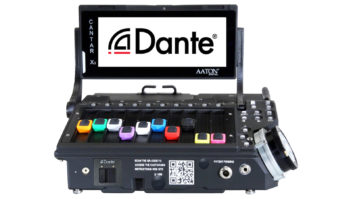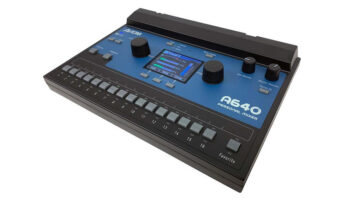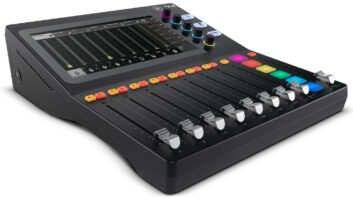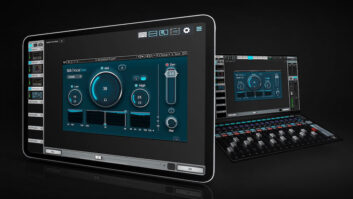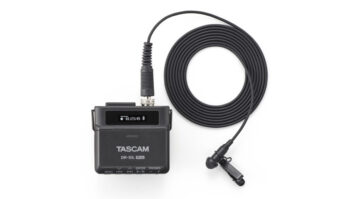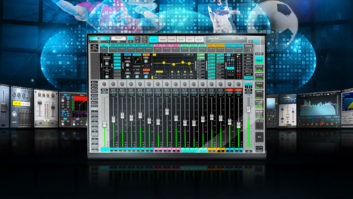
The Cantar-X field recorder, designed by French film camera maker Aaton, covers almost every conceivable requirement for video and film, with multichannel 24/96, simultaneous recording to a 2.5-inch internal HD and CD-R/DVD+R/DVD-RAM (internal or external) in a slick, ergonomic package.
The Cantar-X is the size of a Nagra and about as solid. Its case is a metal alloy and its six linear playback mixer faders are waterproof. The unit was configured with three mono and two stereo mic inputs, a pair of stereo line inputs and eight channels via digital I/O on a DB-25 connector. Word, video ref, LTC and reserved I/O are on a DB-15 connector with breakout cable. Timecode I/O functions appear on a 5-pin Lemo connector.
Flanking the unit’s left and right are two rechargeable batteries (on 4-pin XLRs) that provide 10 to 15 hours of operation, depending on configuration. An alarm goes off when the juice is low, and both batteries can be online together. Cantar-X connects with Wintel and Apple platforms via FireWire and (with an optional module) a Bluetooth-enabled Palm PDA.
GETTING CONTROL
The front panel has three round and one rectangular LCDs. On the top panel are rotary knobs for the mic and line input level controls. Like “split desks” of old, the linear faders (top left) are for playback monitoring; the resulting submix can be bounced to tracks 7 and 8. The little silver buttons are for solo, channel selection and on/off for channel, phantom power and limiting.
A recorder with a built-in mixer is not unusual, but one with virtual patchbay and router can simplify changeovers. All mic and line inputs can be routed and panned to any of the six tracks (plus a 2-track stereo mix), with playback monitoring being its own subset of presets. While Cantar-X has a learning curve, the time invested to learn the presets — or rolling your own — will pay off on the job.
The multifunction Main Selector on the far-right side handles play, stop, test, record and allows access to technical, copy/backup, session, audio setup and routing functions. The three round LCDs serve multiple duties, including level, balance, phase, phantom power and limiter-enable. At the center of each display, tracks that are record-enabled are also displayed, as are the number and type of drives, both internal and external. The rectangular alphanumeric message panel reports take and scene numbers, as well as battery level, time of day, timecode and more.
A system clock embeds the project name, date and time of recording into the audio files as metadata to make it easier to keep track of things on the post side.
IN THE FIELD
I used Cantar-X in four different tests: setup/record, simultaneous record to multiple drives, file management and transfer (via computer) and software update. The only glitch I encountered was formatting the DVD-RAM to the FAT32 file system; hard drives must also be externally formatted for FAT32. This can be done on Apple and Wintel; incremental DVD±R recording is now in the works. Recording is possible to any/all drives (up to three). On playback, each drive can be separately monitored.
I tested Cantar-X with two different external drives — HD and DVD-RAM — and the internal HD. In this case, the multi-DVD recorder was only recognized as a CD reader. To fix this, I found the drive’s make and model and downloaded a driver from Panasonic’s Website.
On the internal HD, I recorded dialog at 48 kHz/24-bit with a close mic and a pair of omni mics for ambience — all condensers. The mixer and headphone level controls delivered plenty of juice to the cans. The sound was warm and detailed without being strident or abrasive.
I did not test the Palm-related options, but did take advantage of an Aaton alpha utility called Majax to open Cantar’s files on my PC. Aaton’s Majax software allows the files to be viewed, opened and played via a standard soundcard. A future version will also include submixing and file conversion. Majax will play from any drive — local or FireWire — including Cantar’s internal drives.
From the technical menus, the internal drives can be unmounted, allowing FireWire access by the outside world. Cantar’s drives show up on the desktop similar to any USB or FireWire drive, and as long as the directory tree is kept intact, can be played by Majax. Annotation of metadata and audio data is planned for the future.
THAT’S A WRAP
The Aaton Cantar-X is a well-thought-out, full-featured, fun-to-use product. Yes, its $15,000 price tag is steep — almost one-and-a-half times more than the Zaxcom Deva — but for those who are employed most of the year doing feature films and network/cable TV, Cantar-X could make demanding multichannel multiple setup jobs a pleasure. Plus, it can be rented, a great try-before-you-buy option. Every mixer I know wants to check it out: All of them were just a little jealous that I got it first.
Aaton, 33/4/7642/9550, www.aaton.com.

